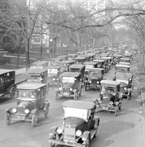
The Automobile Shapes The City
Traffic and Congestion
Despite the continual expansion of the street and road system in core cities—or because of it—traffic congestion is the most striking physical impact of rising motor vehicle use in the twentieth century. It is a manifestation of how cities are utilized and the degree to which the urban environment is capable of absorbing or rationalizing the process of people moving. Automobiles did not invent traffic jams, but they intensified them with the introduction of mass-produced automobiles packed into spaces not prepared to accept the new transit mode. Older towns and cities in the pre-car era faced severe traffic congestion, and in response those in the new field of city planning proposed making streets wider, sidewalks narrower, and blocks longer. The broadened roads encouraged more traffic but made pedestrians less safe, and new construction created more barriers in neighborhoods or fragmented them. As one observer noted, “As a technology the auto did not create contemporary traffic problems any more than use of the horse did in nineteenth-century cities. Rather it is the overuse of the auto and the accommodation of social space to it—as a homogenous system of mobility—that is the problem.”
Initially, cars, trucks, and buses mixed with other forms of transportation, including horses, wagons, and streetcars, all of which took up different amounts of space and traveled at different speeds. Even in more recent times, all vehicles are not alike, and the merging of several types of motorized conveyances in a variety of weather conditions, facing untold road conditions and construction, and in some cases having to contend with pedestrians, makes traffic congestion a chronic problem.
Prior to World War I, New York was experiencing traffic jams twice each day during an early form of “rush hour,” forcing some people to consider returning to the subways instead of driving to work. More than 49,000 motorized vehicles daily entered Chicago’s Loop. More cars and more car trips to and from home and work made traffic a popular point of discussion in local newspapers and in the streets themselves. In some cases, motorists were quick to blame foreign-born teamsters and other drivers of commercial vehicles for the traffic problems in this period. Beginning in 1921, for example, the Detroit police forced truck drivers to take a special test to prove their driving skills.
Concern over automobile congestion has been longstanding and persistent. In the wake of the traffic snarls appearing as early as the 1910s, traffic studies carried out in the 1930s through 1950 suggested that motorized vehicle travel (along with congestion and accidents) tended to be concentrated on limited stretches of main roads and streets leading to major destinations. Traffic volume, therefore, rose primarily near cities, reaching a peak in downtown areas of six times the volume of traffic in suburbs. The typical urban grid system of streets only worsened the traffic pressure on the central cities, as did the tendency for the street and road systems to bring traffic to the center of town.
Viewed as the principal urban transportation problem by the mid-twentieth century, traffic congestion emerged as the foremost justification for large-scale highway construction in American urban areas after World War II. Planners, however, sometimes seemed oblivious to the fact that building urban expressways in order to reduce congestion and increase traffic speeds could encourage additional automobile usage, not less. A variety of negative side effects—increased pollution, increased gasoline and oil use, and potential safety problems—was the result, quite the inverse of the stated goals of greater highway construction. Planners have looked to newer technical solutions to congestion in recent years, as well as to new road and street designs. For example, officials in Los Angeles and New York employed sensors, computers, and robot video cameras to reduce rush-hour congestion. Others hope that telecommuting—workers spending part of their time at home conducting business by computers and fax machines—will reduce the traffic crunch.
Getting automobiles into the “flow” of traffic is a long-standing problem exacerbated by the simple fact that motorized vehicles tended to occupy greater street area per person than common carriers. A Boston report in the early 1920s estimated that one person in a filled five-passenger car was using 17 times as much street space as one person in a streetcar at capacity. In recent times, congestion problems in core cities and across metropolitan areas have worsened rather than eased. Motor-vehicle use in the United States doubled from one to two trillion miles between 1970 and 1990. Between 1960 and 1990, traffic increased by a factor of five in the Seattle area. In Washington, D.C., traffic almost tripled from 1973 to 1994. In California, vehicle use doubled between 1970 and 1990, growing more than four times faster than population. A 1990 study stated that the average California driver spent 84 hours a year stuck in traffic congestion. This suggests that as much as the introduction of automobiles into cities would come to modify urban space, accommodating them in motion has been a challenging and frustrating problem.
<<Previous Section - Next Section>>
Introduction
The “Footprint” of the Automobile on the American City
From “Walking Cities” to “Automobile Cities"
Traffic and Congestion
Filling Stations and Other Services
Expressways, Freeways, and Superhighways
Complete Text Printable View
About the Project | Credits | Contact Us | Student & Teacher Resources | Site Map
©2004-2010 Automobile in American Life and Society
